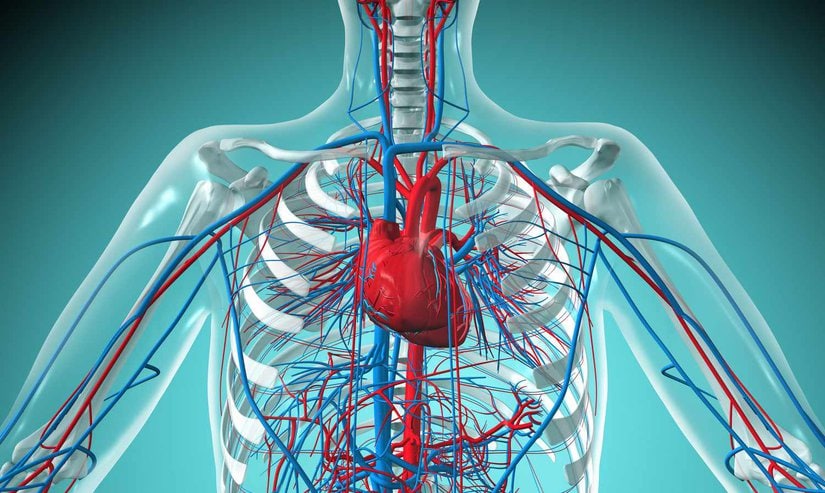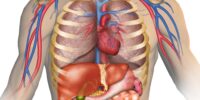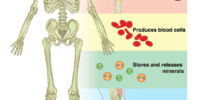What Is The Cardiovascular System?

The cardiovascular system, also known as the circulatory system, is responsible for the transportation of blood and nutrients throughout the body. This complex system consists of the heart, blood vessels, and blood, all of which work together to maintain homeostasis and ensure that every organ receives the oxygen and nutrients it needs to function properly.
The heart, a muscular organ located in the chest, is the center of the cardiovascular system. Its main function is to pump blood to the rest of the body, delivering oxygen and nutrients to cells and removing waste products.
Blood vessels, including arteries, veins, and capillaries, are responsible for transporting blood to and from the heart and throughout the body.
Blood, which is composed of plasma and various cellular components, plays a crucial role in the cardiovascular system by carrying oxygen, nutrients, and hormones to cells and tissues and removing waste products.
Together, these components make up the complex and essential system that is the cardiovascular system.
Key Takeaways
- The cardiovascular system consists of the heart, blood vessels, and blood and is responsible for transporting blood and nutrients throughout the body.
- Maintaining cardiovascular health involves exercise, a balanced diet, and avoiding harmful habits such as smoking, and medical interventions such as medications and surgical procedures may be necessary.
- Factors that can negatively affect cardiovascular health include smoking, poor diet, lack of exercise, hypertension, diabetes, high LDL cholesterol, obesity, and family history of heart disease.
- Advancements in cardiovascular health include the use of biomarkers and AI for early detection and diagnosis of cardiovascular disease, as well as research into stem cells for repairing damaged heart tissue and regenerating blood vessels.
The Heart: Anatomy and Function
The heart, a muscular organ located in the thoracic cavity, is responsible for pumping blood throughout the body and maintaining a constant flow of nutrients and oxygen to the tissues.
The heart is divided into four chambers, with two atria and two ventricles.
The atria are smaller and located at the top of the heart, while the ventricles are larger and located at the bottom.
The right side of the heart pumps blood to the lungs, where it is oxygenated, while the left side of the heart pumps oxygenated blood to the rest of the body.
The heart is also equipped with a specialized electrical system that controls the rate and rhythm of its contractions.
This electrical system is made up of specialized cells that generate electrical impulses, which travel through the heart and cause it to contract.
The sinoatrial (SA) node, located in the right atrium, serves as the heart’s natural pacemaker and initiates each heartbeat.
The atrioventricular (AV) node, located between the atria and ventricles, delays the electrical impulses before sending them on to the ventricles.
This delay ensures that the atria have fully contracted before the ventricles begin to contract, allowing for efficient blood flow.
Blood Vessels: Arteries, Veins, and Capillaries
Arteries, veins, and capillaries are the three types of blood vessels that make up the circulatory network in the human body.
Arteries are blood vessels that carry oxygenated blood away from the heart and to the rest of the body. They have thick walls made up of smooth muscle and elastic fibers that allow them to withstand the high pressure of blood flow from the heart. Arteries branch out into smaller vessels called arterioles, which regulate blood flow through the body’s tissues. The narrowing and widening of arterioles, known as vasoconstriction and vasodilation, respectively, play a crucial role in regulating blood pressure.
Veins are blood vessels that carry deoxygenated blood back to the heart. Unlike arteries, veins have thinner walls and contain valves that prevent the backflow of blood. They rely on the contraction of surrounding muscles to push blood back to the heart.
Capillaries, on the other hand, are the smallest blood vessels in the body and are responsible for the exchange of oxygen, nutrients, and waste products between the blood and the body’s tissues. They are so small that red blood cells can only pass through them in single file, allowing for efficient exchange of gases and nutrients.
Overall, the network of arteries, veins, and capillaries ensures that every cell in the body receives the nutrients and oxygen it needs to function properly.
Blood: Composition and Role in the Cardiovascular System
Blood is a vital component of the human body and plays a crucial role in transporting oxygen, nutrients, and waste products throughout the body. It is composed of various elements, including red blood cells, white blood cells, platelets, and plasma.
Red blood cells contain hemoglobin, a protein that binds with oxygen, allowing it to be transported to the body’s tissues. White blood cells, on the other hand, play a vital role in the immune system, helping to defend the body against infections and diseases. Platelets help with blood clotting, which is essential in preventing excessive bleeding.
Plasma is the liquid component of blood and contains various proteins, nutrients, and hormones that are essential for the body’s functioning. It also helps to regulate the body’s pH levels and plays a crucial role in maintaining the body’s fluid balance. Additionally, plasma contains antibodies, which help to fight infections and diseases.
The composition of blood is essential for the proper functioning of the cardiovascular system, which relies on the efficient transport of oxygen and nutrients to the body’s tissues. Understanding the role of blood in the cardiovascular system is critical in maintaining overall health and preventing various diseases and conditions.
Circulation: How Blood Flows Through the Body
The flow of blood throughout the body is a complex process that involves the coordination of various structures and mechanisms. Blood is propelled through the circulatory system by the heart, which pumps it into the arteries.
From the arteries, blood flows into smaller vessels called arterioles, which then lead to the capillaries. Capillaries are tiny, thin-walled vessels that allow for the exchange of oxygen, nutrients, and waste products between the blood and the body’s tissues.
After leaving the capillaries, blood flows into the venules, which then lead to the veins. Finally, the blood is returned to the heart through the veins, completing the circulation process.
To better understand the complex process of blood circulation, here are some key points to consider:
- Blood flows from the heart into the arteries, which carry oxygen-rich blood away from the heart and into the body’s tissues.
- Capillaries allow for the exchange of oxygen, nutrients, and waste products between the blood and the body’s tissues.
- Blood is then carried back to the heart through the veins, which contain one-way valves that prevent the backflow of blood.
The entire circulatory system, including the heart, blood vessels, and blood, is essential for maintaining the body’s overall health and functioning.
Regulation: Control of Heart Rate and Blood Pressure
Regulation of heart rate and blood pressure is a crucial aspect of maintaining proper cardiovascular function. The cardiovascular system works to deliver oxygen and nutrients to all organs and tissues in the body, and it relies on the proper regulation of heart rate and blood pressure to do so.
Heart rate refers to the number of times the heart beats per minute, while blood pressure refers to the force of blood against the walls of the arteries. Together, these two factors determine how efficiently the cardiovascular system is able to transport blood throughout the body.
The regulation of heart rate and blood pressure is controlled by a complex interplay between the nervous system, hormones, and other physiological factors. The autonomic nervous system, which is responsible for controlling involuntary bodily functions, plays a significant role in regulating heart rate and blood pressure. It consists of two branches, the sympathetic and parasympathetic nervous systems, which work together to maintain balance and control over the cardiovascular system.
Hormones such as adrenaline and noradrenaline also play a role in regulating heart rate and blood pressure by stimulating the heart and constricting blood vessels. In order to maintain proper cardiovascular function, it is important to maintain a healthy lifestyle and manage any underlying health conditions that may impact heart rate and blood pressure.
Cardiovascular Diseases: Common Conditions and Risk Factors
Common conditions and risk factors associated with diseases affecting the heart and blood vessels are numerous and varied.
Lifestyle factors such as smoking, poor diet, and lack of exercise have all been linked to increased risk of cardiovascular diseases. Smoking is a major risk factor for cardiovascular diseases, as it damages the lining of blood vessels, increases blood pressure, and reduces oxygen levels in the blood.
A diet high in saturated and trans fats, salt, and sugar can also contribute to cardiovascular diseases by increasing levels of LDL cholesterol, blood pressure, and inflammation. Lack of regular exercise can also increase the risk of cardiovascular diseases by promoting weight gain, reducing fitness levels, and contributing to other risk factors like hypertension and diabetes.
Underlying health conditions such as hypertension and diabetes are also major risk factors for cardiovascular diseases. Hypertension, or high blood pressure, can damage the walls of blood vessels and increase the risk of heart attack and stroke. Diabetes, particularly type 2 diabetes, is also associated with an increased risk of cardiovascular diseases, as it can damage blood vessels and nerves throughout the body.
Other underlying health conditions that can increase the risk of cardiovascular diseases include high levels of LDL cholesterol, obesity, and family history of heart disease. By addressing these common risk factors and underlying health conditions, individuals can take steps to reduce their risk of developing cardiovascular diseases and protect their heart health.
Prevention and Treatment: Lifestyle Changes and Medical Interventions
Prevention and treatment of conditions affecting the heart and blood vessels can be achieved through a combination of lifestyle changes and medical interventions.
Lifestyle modifications that promote cardiovascular health include exercise, a balanced diet, and avoiding harmful habits such as smoking and excessive alcohol consumption. Regular physical activity can improve heart function, reduce blood pressure, and maintain a healthy weight. A diet rich in fruits, vegetables, whole grains, and lean protein can provide the necessary nutrients for optimal cardiovascular health, while minimizing the intake of saturated and trans fats, cholesterol, and sodium. Quitting smoking and limiting alcohol consumption can also significantly reduce the risk of developing cardiovascular diseases.
Medical interventions may be necessary for individuals who have already developed cardiovascular diseases or who are at high risk due to factors such as family history or age. Medications such as statins and ACE inhibitors can help manage hypertension and high cholesterol levels, while anticoagulants and antiplatelet drugs can reduce the risk of blood clots. In some cases, surgical procedures such as coronary artery bypass grafting or angioplasty may be necessary to restore blood flow to the heart.
However, these interventions should be complemented with lifestyle changes to achieve optimal outcomes. By working together, individuals can reduce their risk of developing cardiovascular diseases and improve their overall health and well-being.
Future Directions: Research and Advancements in Cardiovascular Health
Advances in medical technology and genetic research are paving the way for more personalized and precise approaches to improving heart health. One area of research that has gained attention is the development of biomarkers that can accurately predict an individual’s risk for developing cardiovascular disease (CVD). These biomarkers can be identified through genetic testing, blood tests, or imaging techniques, and can provide valuable information about an individual’s unique risk factors and potential treatment options.
Another promising area of research is the use of artificial intelligence (AI) and machine learning algorithms to improve early detection and diagnosis of CVD. By analyzing large amounts of medical data, these technologies can identify subtle patterns and predict the likelihood of developing CVD. This can lead to earlier interventions and more targeted treatment plans for individuals at risk.
Additionally, there is research being conducted on the use of stem cells for repairing damaged heart tissue and regenerating blood vessels, which could potentially revolutionize the treatment of CVD in the future.
Conclusion
In conclusion, the cardiovascular system is a complex network of organs, vessels, and cells that work together to transport blood, oxygen, and nutrients throughout the body.
The heart is the main organ of the system, responsible for pumping blood through the blood vessels.
The blood vessels are classified into arteries, veins, and capillaries, each with a specific function in the circulation process.
Blood is composed of plasma, red and white blood cells, and platelets, and plays a vital role in the cardiovascular system.
The circulation process involves the movement of blood through the body, from the heart to the organs and back.
The regulation of heart rate and blood pressure is crucial for maintaining a healthy cardiovascular system.
Cardiovascular diseases are a common health problem, but prevention and treatment options are available, including lifestyle changes and medical interventions.
Advancements in research are being made to improve cardiovascular health and reduce the prevalence of these diseases.









